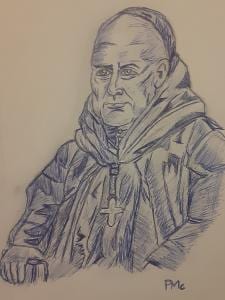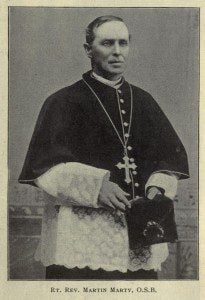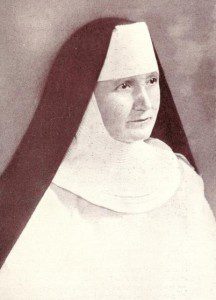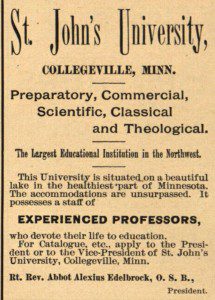 If you’ve never heard of the Liturgical Movement, you’re missing out on one of the most dynamic components in modern Catholic history. It has its roots in France’s thousand-year-old Solesmes Abbey, which was shut down during the French Revolution. In the 1830’s, a young priest named Prosper Guéranger (1805-1875) restored Solesmes and revived Benedictine monasticism in France. Since childhood Dom Prosper (his monastic title) was enamored with the romance and beauty of the ancient Christian past, and as a monk he aimed to rediscover the roots of Christian worship.
If you’ve never heard of the Liturgical Movement, you’re missing out on one of the most dynamic components in modern Catholic history. It has its roots in France’s thousand-year-old Solesmes Abbey, which was shut down during the French Revolution. In the 1830’s, a young priest named Prosper Guéranger (1805-1875) restored Solesmes and revived Benedictine monasticism in France. Since childhood Dom Prosper (his monastic title) was enamored with the romance and beauty of the ancient Christian past, and as a monk he aimed to rediscover the roots of Christian worship.
Today he’s remembered mainly for promoting Gregorian Chant, which had fallen into disuse for some time. He sent monks across Europe to examine ancient musical compositions, with an eye toward reincorporating them into the liturgy. His multi-volume series The Liturgical Year was also popular in Catholic circles. It aimed toward, in elaborate nineteenth century rhetoric:
The Supreme Worship of the Ever Blessed Trinity, in the Communion of the Saints. Into this interior world of heavenly beauty, splendor, and peace, the Liturgy of the Church admits us day by day.
Heavenly beauty, splendor and peace– this was the Liturgical Movement’s goal– to reclaim the ancient roots of Christian worship and promote greater participation therein.
The movement strongly influenced St. Pius X (1903-1914), who formally promoted chant’s primacy in Church documents, so Christians could “worship with beauty.” While Pius isn’t often seen as a “reforming” pope, Church historians note that he did indeed reform the liturgy by stressing greater lay participation, especially as it applied to frequent reception of Communion. Pius stressed the liturgy as the primary, and indispensable, source of the Christian life.
During the first half of the twentieth century, in the United States, the Liturgical Movement flourished in Benedictine circles, particularly at St. John’s University in Collegeville, Minnesota. This was due in large part to a young monk named Virgil Michel (1890-1938), who built on its European roots to emphasize the connection between the Eucharist and what Pius XI termed “Catholic Action.” Long before Vatican II, Pius XI (1922-1939) was particularly concerned about Catholics making a concrete difference in the world, especially when it came to social action.
For Michel, when Christians viewed themselves as part of what St. Paul calls Christ’s “Mystical Body,” they could better realize their responsibilities and obligations to one another. Building on recent papal teaching, he created a syllogism that runs like this:
- The liturgy is the primary and indispensable source of the true Christian spirit.
- The true Christian spirit is indispensable for social regeneration.
- Therefore, the liturgy is the indispensable basis of social regeneration.
In a letter written toward the end of his life, Michel wrote that the Mass contained the seeds of “the unifying bond” tying Christians “to God and to each other in an intimate social fellowship.” The Liturgical Movement was a strong influence on many American Catholic leaders, especially Servant of God Dorothy Day (who was herself a longtime Benedictine Oblate). Pius XII’s 1947 encyclical Mediator Dei, which stressed greater lay participation in the liturgy, was in part a response to the influence of the Liturgical Movement.
What did Vatican II say about all this? The 1963 Constitution on the Sacred Liturgy, Sacrosanctum Consilium, stressed what it called “fully conscious, and active participation” by the laity:
While the liturgy daily builds up those who are within into a holy temple of the Lord, into a dwelling place for God in the Spirit, to the mature measure of the fullness of Christ, at the same time it marvelously strengthens their power to preach Christ, and thus shows forth the Church to those who are outside as a sign lifted up among the nations under which the scattered children of God may be gathered together, until there is one sheepfold and one shepherd.
As Catholic Christians, then, we’re all called to “show forth the Church to those outside.” That is, to make a difference in that larger world in which we find ourselves. At the end of Mass, as the Deacon exhorts us to go forth, our job is to serve God and others.
This has always been a key element of the liturgy, in whatever language it’s celebrated. In our world today, people, both religious and non-religious (maybe the latter most of all) are starving to see Christians really live out their beliefs. So we can’t compartmentalize prayers and actions. The Mass helps unite them, helping us build Christ’s Body in the world. The Liturgical Movement of the 19th and 20th centuries can help remind us of this need, as urgent today as it was then. Let me conclude with what St. Teresa of Avila had to say on making a difference in the world:
Christ has no body now but yours. No hands, no feet on earth but yours. Yours are the eyes through which he looks with compassion on this world. Yours are the feet with which he walks to do good. Yours are the hands through which he blesses all the world. Yours are the hands, yours are the feet, yours are the eyes, you are his body. Christ has no body now on earth but yours.
(The drawing of Dom Prosper is by Pat McNamara.)











